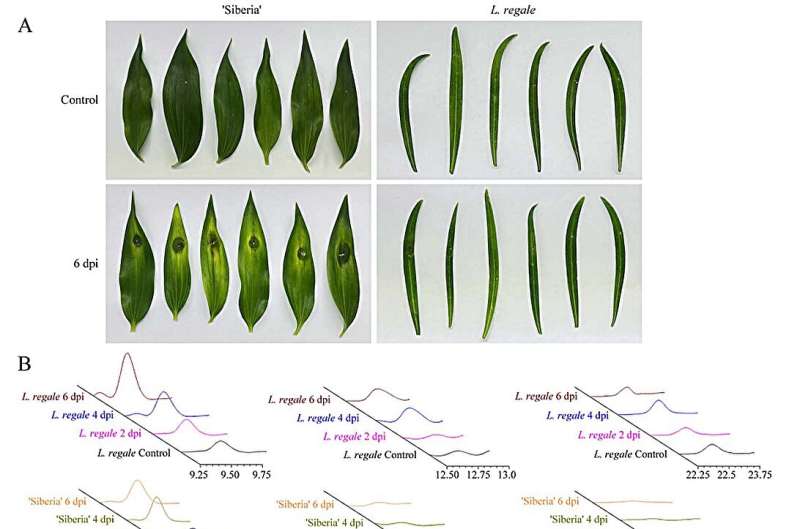This article has been reviewed according to Science X's editorial process and policies. Editors have highlighted the following attributes while ensuring the content's credibility:
fact-checked
peer-reviewed publication
proofread
Bulwark of blooms: The lily's secret armor against plant pathogens

Fusarium wilt is a severe threat to the global cut-flower industry, particularly impacting lilies. Caused by Fusarium oxysporum, this disease results in significant economic losses due to plant decay and death. Traditional breeding methods have struggled to create resistant varieties, largely due to the complex genetic and metabolic factors involved in disease resistance. Addressing these challenges requires exploring the resistance mechanisms in wild species like Lilium regale, to identify potential pathways and genes for crop improvement.
Researchers at Kunming University of Science and Technology published a study on May 20, 2024, in Horticulture Research, investigating Lilium regale's resistance to Fusarium wilt.
Using a multi-omics approach, the study combined transcriptomics, proteomics, and metabolomics to decode the complex defense mechanisms in this wild lily. The research emphasizes the crucial role of phenylpropanoid metabolism in conferring resistance, with implications that could guide future breeding programs aimed at improving disease resistance in commercially important lily varieties.
The study's multi-omics analysis identified significant upregulation of phenylpropanoid metabolism-related genes and pathways in Lilium regale after Fusarium oxysporum infection. Key metabolites such as lignin, flavonoids, and hydroxycinnamic acids were found to accumulate at higher levels in resistant lilies compared to susceptible ones. These metabolites not only fortified the plant's physical barriers by enhancing cell wall composition but also exhibited direct antifungal properties, curbing the pathogen's growth and reducing its virulence.
Additionally, ethylene-responsive transcription factors (ERFs), especially LrERF4, were found to play a pivotal role in regulating these metabolic pathways. Overexpression of LrERF4 in susceptible lily varieties enhanced resistance, further emphasizing the importance of phenylpropanoid metabolism in the plant's defense strategy. This comprehensive analysis offers deeper insights into the molecular and biochemical foundations of quantitative resistance in plants, opening new pathways for breeding disease-resistant crops.
Dr. Diqiu Liu, the senior researcher, emphasized the study's significance, saying, "Integrating multi-omics approaches to understand complex plant defense mechanisms is crucial. By uncovering the role of phenylpropanoid metabolism in Lilium regale's resistance to Fusarium wilt, we provide a robust foundation for future breeding programs. The discovery of key regulatory genes like LrERF4 unlocks new possibilities for developing disease-resistant varieties, with potentially transformative effects on the horticulture industry."
This study has far-reaching implications for the horticulture industry. Identifying phenylpropanoid metabolism as a key defense mechanism in Lilium regale presents a promising target for breeding disease-resistant lily varieties. Moreover, the regulatory role of LrERF4 offers opportunities to engineer crops with improved resistance to Fusarium wilt and possibly other fungal diseases. By applying these insights, breeders could develop more resilient plants, ensuring stable production and reducing losses due to disease, ultimately benefiting the global flower market.
More information: Deng, J. et al. Integrated multi-omics investigation revealed the importance of phenylpropanoid metabolism in the defense response of Lilium regale Wilson to fusarium wilt. Horticulture Research, doi.org/10.1093/hr/uhae140, academic.oup.com/hr/article/11/7/uhae140/7676813
Journal information: Horticulture Research
Provided by TranSpread


















